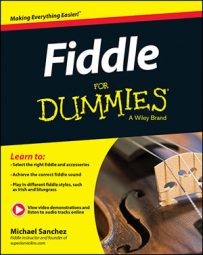One very important part of playing the fiddle is knowing how to rosin the bow — the process of applying rosin to create a sticky film on the bow hair. Rosin comes in many different sizes and shapes and is universally used to help the bow hair grab the strings better. Without putting rosin on the bow, your fiddle will have a wispy, airy sound when you play.
If you’ve used a bow, chances are it still has a light coat of rosin on it. To start, you need to determine how much rosin is on your bow. Simply take the back of your finger and swipe the bow hair toward the frog area.
Don’t use the front of your finger or the oils from your hands may get the bow hair dirty. Avoid testing rosin levels at the middle of the bow because you especially want the bow hairs in this area to stay clean. If there’s no rosin on your finger, you’ll need to apply some.
If you see that your finger is pure white, the bow has too much rosin on it. If this is the case, take your finger and flick the back of the bow hairs to take off some of the rosin. You can also use a light paper towel to take off rosin, but avoid touching the front of the bow hairs with your fingers if possible.
![[Credit: By Rashell Smith]](https://www.dummies.com/wp-content/uploads/458862.image0.jpg)
Here’s how to apply rosin to your bow:
Grab your rosin block and scratch it to bring rosin powder to the top.
Scratch the rosin by using the screw of the bow or a nail file on the surface of the rosin.
![[Credit: By Rashell Smith]](https://www.dummies.com/wp-content/uploads/458863.image1.jpg) Credit: By Rashell Smith
Credit: By Rashell SmithTake your tightened bow (don’t be afraid to tighten it a little more than normal) and start putting rosin on the bow hair.
The motion of this should be similar to scrubbing a counter stain or shining your shoes. Spend a few seconds in each area of the bow and apply rosin evenly throughout, going up and down the bow to get a nice even coat. Again, don’t be afraid to dig into the rosin with your bow because you want the rosin to stick to the bow hairs.
Test to see how much rosin is on the bow by carefully taking the back of your finger and testing it like you did before, but don’t do this often.
If it’s a new bow, you may not notice a lot of rosin in certain spots. It may take up to five minutes of rosining a new bow if you’re being too delicate with it.
After you have enough rosin on the bow, you have to reapply it every 60 minutes of practice.
This normally equates to once every other practice session. Each time you put more rosin on the bow, it usually only needs five to ten seconds’ worth of application to be sufficient.
If you keep using the exact same area on the rosin block when applying rosin to the bow hairs, a groove will be created over time. You’ll have to purchase a new block sooner if you don’t avoid this groove. Each time you apply rosin, use a different part of the block so that you don’t get any unwanted grooves.
If you’ve recently purchased a new fiddle, it probably came with a brand-new bow. This is great, but many people don’t understand the amount of rosin that needs to go on new bows. Be sure to follow all the preceding steps to get enough rosin on the bow.

